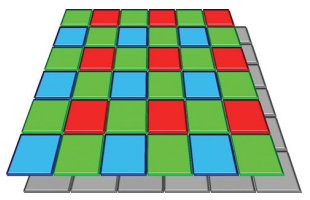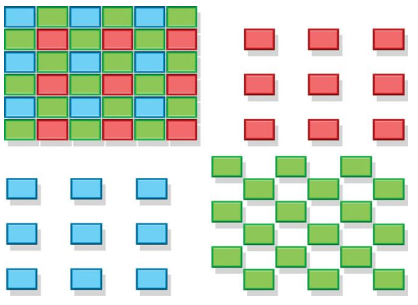Inside Your Digital SLR PART- 5
How We Get Color
So far, I’ve ignored how sensors produce color. In one sense, digital camera sensors are color blind. They can register the brightness, or luminance of an image, but have no notion of the color of the light at all. To do that, most sensors (excepting a special type called Foveon, used in some Sigma cameras, and explained below) overlay the photosites with a set of color filters. Each pixel registers either red, green, or blue light, and ignores all the others. So, any particular pixel might see red light (only), while the one next to it might see green light (only), and the pixel below it on the next row might be sensitive to blue light (only).
As you might guess, in the normal course of events, a pixel designated as green-sensitive might not be lucky enough to receive much green light. Perhaps it would have been better if that pixel had registered red or blue light instead. Fortunately, over a large pixel array, enough green-filtered pixels will receive green light, red-filtered pixels red light,
and blue-filtered pixels blue light that things average out with a fair degree of accuracy.
To compensate for this shortcoming, the actual color value of any particular pixel is calculated through a process called interpolation. Algorithms built into the camera’s circuitry can look at surrounding pixels to see what their color values are, and predict with some precision what each pixel should actually be. For the most part, those guesses are
fairly accurate.
For reasons shrouded in the mists of color science, the pixels in a sensor array are not arranged in a strict red-green-blue alternation, as you might expect to be the case.
Instead, the pixels are laid out in what is called a Bayer pattern (named after Kodak scientist Dr. Bryce Bayer), shown in Figure 1.9, which shows just a small portion of a full sensor array. One row alternates green and red pixels, followed by a row that alternates
Figure 1.9= To allow the sensor to capture color, a matrix of red, green, and blue filters is placed over the photosites.
green and blue filters. Green is “over-represented” because of the way our eyes perceive light: We’re most sensitive to green illumination. That’s why monochrome monitors of the computer dark ages were most often green-on-black displays.
The process of interpreting the pixel values captured and transforming them into a more accurate representation of a scene’s colors is called demosaicing. With good algorithms, the process is accurate, but faulty demosaicing can produce unwanted artifacts in your photo (although, almost by definition, artifacts are generally always unwanted).
Of course, use of a Bayer pattern means that a great deal of the illumination reaching the sensor is wasted. Only about half of the green light is actually captured, because each row consists of half green pixels and half red or blue. Even worse, only 25 percent of the red and blue light is registered. Figure 1.10 provides a representation of what is going
Figure 1.10= There are twice as many green pixels in a raw captured image as red and blue pixels.
on. In our 36 pixel array segment, there are just 18 green filtered photosites and 9 each of red and blue. Because so much light is not recorded, the sensitivity of the sensor is reduced (requiring that much more light to produce an image), and the true resolution is drastically reduced. Your digital camera, with 10 megapixels of resolution, actually captures three separate images measuring 5 megapixels (of green), 2.5 megapixels (of blue), and 2.5 megapixels (of red).
Figure 1.11= The Foveon sensor has three layers, one for each primary color of light.
Next Topic-- Infrared Sensitivity.




Upvoted.
DISCLAIMER: Your post is upvoted based on curation algorithm configured to find good articles e.g. stories, arts, photography, health, etc. This is to reward you (authors) for sharing good content using the Steem platform especially newbies.
If you're a dolphin or whales, and wish not to be included in future selection, please let me know so I can exclude your account. And if you find the upvoted post is inappropriate, FLAG if you must. This will help a better selection of post.
Keep steeming good content.
@Yehey
Posted using https://Steeming.com condenser site.
Thanks for your Suggestion.
I will try to my best for follow your Suggestion.